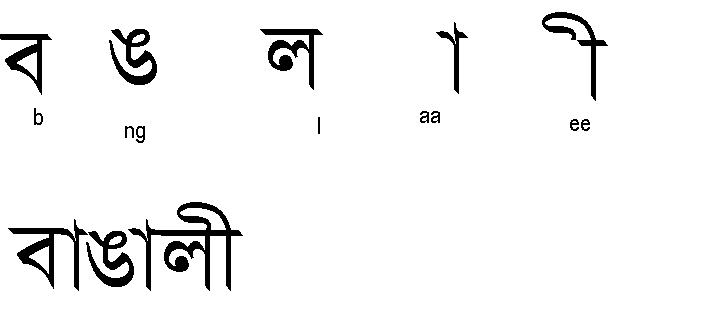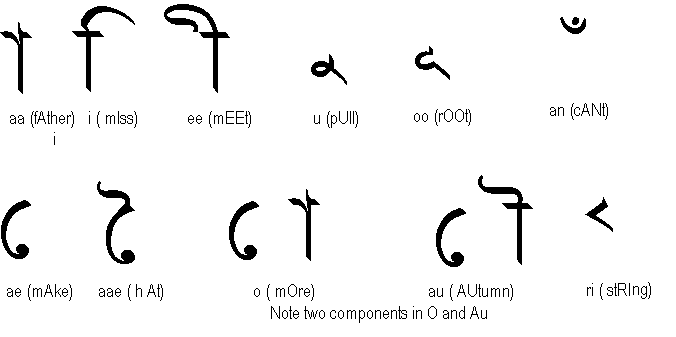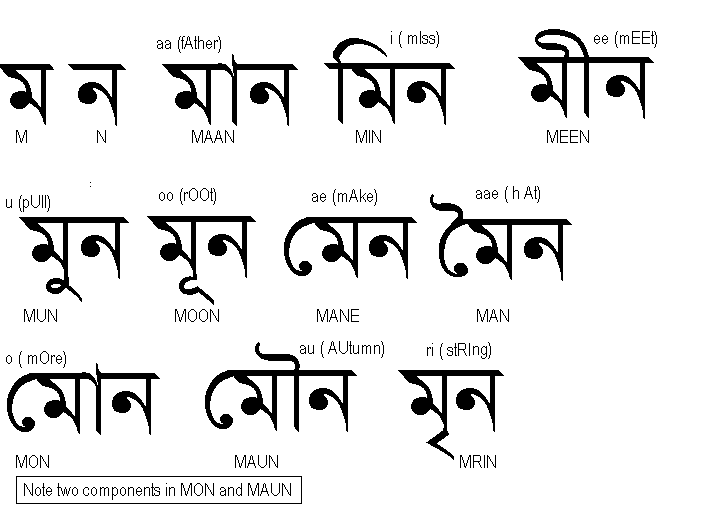Lesson 2......Home Page..Golshani's alphabet comparison page...Bengali Newspaper-remember to save the instructions to change the font back
.. If you need an unzip program click here www.winzip.com
If you have enjoyed doing these lessons and would like to help develop the web site further you might consider a small donation of £3 or $5 . Please send cash in envelopes ( not cheques or money orders as it costs more to process ) to Ukindia, P.O. Box 346 Nottingham , NG8 5FX. All which have an email address will be acknowledged by email.
Home..Tamil.Gujarati. Punjabi. Hindi.Urdu.Sanskrit. Arabic.Greek.English. Russian. Hebrew..Mathematics..Science Update
If you want to have a look at the whole alphabet click here Alphabet. Most lessons are titled so you can save them as a bookmark
Bengali is a very poetic and popular language of the subcontinent . It is the mother tongue of Bangladesh and of West Bengal and is also spoken in immigrant communities in the West. . You might find it easier to do the Hindi lessons first Hindi. These lessons are compiled with the help of Sameer Khan. Benglali is spoken exactly as it is written so being a phonetic language it is very easy to learn to read . Write to let us know how you like these lessons and any other suggestion
Home Page..Lesson 2
Here are the letter B , NG , L and the vowel mark for AA and EE . See if you can read your first word in Bengali underneath the letters.

Answer
.
Of course its Baangaali ( Bengali) ! - bAAngAALEE is how the Bengalis say the word for their own tongue.

It is hard to get vowel sounds right in any foreign language . Please read these very helpful comments by Rashid Ullah before proceeding
Congratulations on a fine site. There are, I must point out, some flaws
that can easily be corrected.
I find that Mr. Sameer Khan's corrections, though tacked on at the bottom,
have not been implemented into the main lessons. The most grievous errors
occur with the treatment of vowels and the consistent use of Hindi vowel
sounds for the last four vowels, which you people label AE, AAE, O, and AU.
Mr. Sameer Khan correctly insists that two of these vowels do not resemble
the Hindi analogs, but in the lessons, the incorrect explanations are
maintained, and worse, English words are given "transliterated" in Bengali
script, but done wrong, thus misleading students more.
The vowels labeled AE, AAE, O, and AU should first and foremost be
re-labelled as
E, OI, O, and OU, respectively. E and O sound like their Hindi
counterparts, but OI is the sound of O followed by I (a diphthong, and one
absent in English) and OU is the sound of O followed by U (another
diphthong, much like American English "coat").
When, during the third lesson, you transcribe the English word "at" into
what is supposed to be the Bengali alphabet, you want the students to look
at the Bengali and sound the word "at" because you've taught them the sound
is AAE as in "hat." But, in fact, a native Bengali speaker looking at
example H shall read "oit" not "at." And example J is thus also flawed,
because what in Hindi is the AW sound is in Bengali an OU sound (like
American English "coat"). So example J does not sound like "on" but like
the American English pronunciation of "own."
So much for those four final vowels. Another point, and I don't believe Mr.
Khan explains this: there is really no difference in pronunciation between
the short and long vowels. What you label I and EE are both pronounced the
same, in a sound somewhat like EE in "meet" but shorter. What you label U
and OO are both pronounced the same, somewhat like OO in "fool" but
shorter. Depending on the speaker and the dialect, these sounds can be a
little less extreme, being somewhere between U and OO or somewhere between
I and EE. But my point is: the distinction between short and long has been
lost in Bengali, and speakers make no distinction unless they consciously
try to force the spelling back on to the pronunciation, which yields an
artificial sound.
I hope these corrections are implemented not only as an addendum tacked on
at the end, but are followed through with, thus changing all the flawed
lessons and exercises.
Dhanyavaad (dhonnobaad),
I take note of all your criticism and really do welcome them , as we welcome all criticisms which help the site to become more useful . As far as vowels are concerned it is hard to please everyone as all speak in different accents , for eg. an English would object to someone teaching English with an American accent on the vowels and vice versa ! . The aim of these lessons is really for students to get familiar with the script and then go on to books like the Balaji 'Learn Bengali' . What I need is more help with is to complete the lessons by somebody sending me the answers to the hybrid alphabet letters left unfinished in the other lessons .
Rashad Ullah
Lets look at the vowel marks - the English pronounciation is given as an example in a word, eg the short i is as in the English word Miss

Lets take the letters M and N and add these vowel marks after the M . Note that although the AE and AAE sounds follow after the letter M , they are put before it .Note also that for the O and Au sounds to mark M there are two components of the vowel mark -one which is put before the letter and the other after. These are marked below.

Revise the vowel marks again

And how they modify M

It is important to go over the previous figures again and again until they are imprinted on your mind. Reading the vowel marks correctly is half the battle.
Sameer's comments on the vowels
The vowels are different from Hindi to Bangla: aw (NOT the same sound as in Hindi, it is the sound in "hot" or "lot") aa (similar to Hindi) i (similar to Hindi) ee (similar to Hindi) u (similar to Hindi) oo (similar to Hindi) ri (similar to Hindi) e (similar to Hindi) oi (NOT the same as in Hindi, it is the sound in "loin" or "join") o (similar to Hindi) ou (NOT the same as in Hindi, no similar letter, it's just an "o" that becomes a "u" making an "ou" sound)
Lesson 2..Alphabet.............Home Page